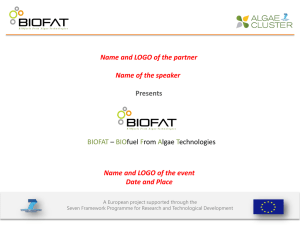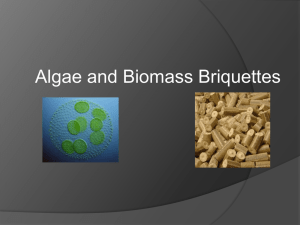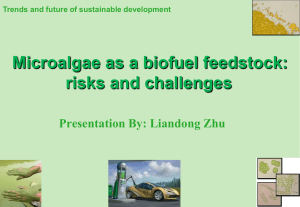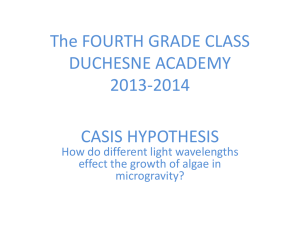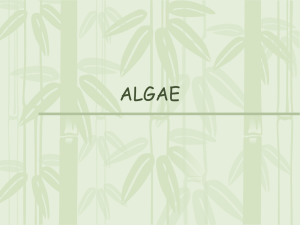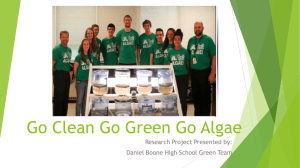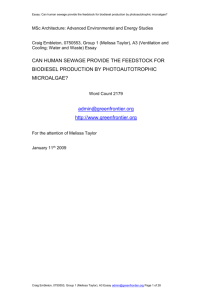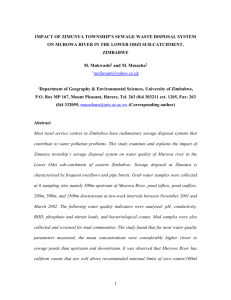MS Powerpoint - Green Frontier
advertisement
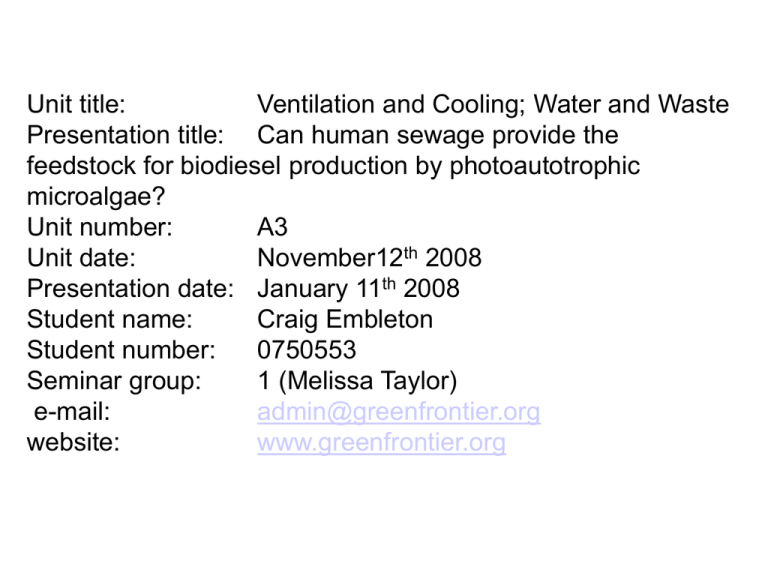
Unit title: Ventilation and Cooling; Water and Waste Presentation title: Can human sewage provide the feedstock for biodiesel production by photoautotrophic microalgae? Unit number: A3 Unit date: November12th 2008 Presentation date: January 11th 2008 Student name: Craig Embleton Student number: 0750553 Seminar group: 1 (Melissa Taylor) e-mail: admin@greenfrontier.org website: www.greenfrontier.org CAN HUMAN SEWAGE PROVIDE THE FEEDSTOCK FOR BIODIESEL PRODUCTION BY PHOTOAUTOTROPHIC MICROALGAE? Contents • Problems with current situation Sewage pollution Conventional biofuels • Sewage treatment Waste stabilisation ponds • Aquatic Species Programme • Algae production Raceway ponds • Oil yield comparison • Conclusions • Questions What are the problems? The usual suspects: • Climate change caused by burning fossil fuels • Peak oil Plus • Sewage pollution wrecks aquatic ecosystems and human health • Conventional biofuel production wrecks terrestrial ecosystems and competes with food production Marine pollution ‘Discharge of untreated domestic wastes is a major source of marine pollution, and perhaps the most serious problem within the framework of the Global Programme of Action’. Source: United Nations Environment Programme report into the state of the marine environment, 2006 1.5 million deaths/year from diarrhoeal diseases attributable to poor sanitation and hygiene .’ Children playing near sewage outlets Source: United Nations Environment Programme, 2006, WHO, 2006 The Trouble with Conventional Biofuel Indonesia currently has: 60,000 square kms of oil palm plantations Plans for another 40,000 by 2015 dedicated to biofuel production alone. Size of Wales: 21,588 square kilometres • Rainforest destroyed. • Huge amounts of fertilizers used. • No reduction in greenhouse gases. • Food prices up. Source: Benemann, J 2008 Is there a solution? Perhaps - Photoautotrophic Microalgae Source: Shell, 2008 What nutrients do algal require to grow? Algal Photosynthesis 106CO2 + 236H2O + 16NH4+ + HPO42- C106H181O45N16P + 118O2 + 171H2O + 14H+ Major Nutrients: Nitrogen and Phosphorus Source: Mara, D 2004 What nutrients are in human waste? (Per person per day) Per adult per day Faeces Urine Nitrogen 3g 8g Phosphorus 2g 2g Potassium 1g 2g Calcium 2g 2g Source: Harper, P. and Halestrap, L. 1999 Waste Stabilisation Ponds Source: Benemann, J 2008 Sewage treatment: algal-bacterial mutualism in waste stabilisation ponds BOD = Biochemical Oxygen Demand Source: Mara, 2004 Aquatic Species Programme (ASP) U.S. Department of Energy’s Office of Fuels Development funded the ASP that ran from 1978-1996 • Focussed on production of biodiesel from algae grown in ponds, using waste CO2 from coal-fired power plants. • The early studies used sewage ponds. • Later studies used fresh and marine water ponds with the addition of agricultural fertilizers. Source: Sheehan, J et al 1998 Aquatic Species Programme (ASP) Programme concluded: Many R&D obstacles but in theory 2,000 square kilometres of climatically suitable land areas in the U.S. could produce one quadrillion (1,000,000,000,000) British Thermal Units (BTU) of fuel. Programme stopped for economic reasons. CHEAP OIL! Source: Sheehan, J et al 1998 Oil yields of crops Crop Maize Soybean Oil yield (L/ha) 172 446 Oil seed rape 1190 Jatropha Oil palm Microalgae grown in raceway ponds. 1892 5950 17,000 Source: Chisti, Y 2007 and J. Benemann, J 2008 Most algae commercially produced in raceway ponds (Arial View) Source: Chisti, Y 2007 Most algae commercially produced in raceway ponds as premium food Because commercially produced algae is usually a premium foodstuff e.g. spirulina • Wastewater (sewage) is avoided. • Expensive agricultural fertilizers used. • Carbonated drinks quality carbon dioxide added. Algae harvested from waste stabilisation ponds Because algal product is a non-food crop: • Wastewater (sewage) can be used. • Expensive agricultural fertilizers avoided. • No addition of CO2 needed but could use flue gases from fossil fuel power stations. Fuel from sewage pond algae Proof of concept by Aquaflow Powered a vehicle with a 5% biofuel mix Source: Aquaflow 2008 Conclusions CAN HUMAN SEWAGE PROVIDE THE FEEDSTOCK FOR BIODIESEL PRODUCTION BY PHOTOAUTOTROPHIC MICROALGAE? Yes – but not yet economically. Much more research needed and tax breaks. Issues - Does algal-biodiesel really not compete with food production? General composition of different human food sources and algae (% of dry matter) Commodity Protein Carbohydrate Lipid Meat 43 1 34 Milk 26 38 28 Rice 8 77 2 Spirulina maxima 60–71 13–16 6–7 Source: Spolaore, P et al, 2005 Issues - Will algal biodiesel perpetuate our oil addiction? • What about electric cars? • What about transitioning to a low carbon economy? • How about using algae to capture carbon and incorporate in soil or bury? Questions? Bibliography • Aquaflow bionomic corporation limited. (2008). Prospectus and investment statement for aquaflow bionomic corporation limited. Available: http://www.aquaflowgroup.com/documents/ProspectusandI nvestmentStatement_001.pdf. Last accessed 31 December 2008. • Benemann, J. (2008). Open ponds and closed photobioreactors – comparative economics. Available: http://www.bio.org/ind/wc/08/breakout_pdfs/20080430/Trac k1_ContinentalA/Session9_230p400pm/Benemann_Contin ental_A_Wed.pdf. Last accessed 1 January 2009. • Broere, W. (2008). Harvesting energy from algae. Available: http://wwwstatic.shell.com/static/aboutshell/downloads/swol/jan_mar_ 2008/algae/algae_en.pdf. Last accessed 30 December 2008. Bibliography Continued • • Catherine Brahic. (2008). Europe unveils ambitious energy plan . Available: http://www.newscientist.com/article/dn13218-europeunveils-ambitious-energy-plan.html. Last accessed 27 December 2008. Coordination Office of the Global Programme of Action for the Protection of the Marine Environment from Land-based Activities (gpa) of the United Nations Environment Programme. (2006). The State of the Marine Environment. Available: http://www.gpa.unep.org/documents/soe__trends_and_english.pdf. Last accessed 26 December 2008 Bibliography Continued • • • Harper, P. and Halestrap, L. (1999) Lifting the Lid. Powys, CAT. Mara, D (2004). Domestic Wastewater Treatment in Developing Countries. London: Earthscan. 3. Available (preview) http://books.google.co.uk/books?id=d9O9Gw_3rOUC&pri ntsec=frontcover&source=gbs_summary_r&cad=0 Last accessed 27 December 2008. Pearce, F. and Aldhous, P.. (2007). Is the biofuel dream over?. Available: http://www.newscientist.com/article/mg19626343.800. Last accessed 23 December 2008. Bibliography Continued • • • Sheehan, J., T. Dunahay, J. Benemann, and P. Roessler (1998). A Look Back at the U.S. Department of Energy’s Aquatic Species Program-Biodiesel from Algae. U.S. Department of Energy’s Office of Fuels Development. Prepared by the National Renewable Energy Laboratory, Golden, Colorado . Available: http://www1.eere.energy.gov/biomass/pdfs/biodiesel_from_ algae.pdf. Last accessed 20 November 2008 Spolaore, P., Joannis-Cassan, C., Duran, E., and Isambert, A. (2006). Commercial applications of microalgae. Journal of Bioscience and Bioengineering, 101(2):87-96. World Health Organisation. (2006). Analysis of estimates of the environmental attributable fraction, by disease. Available: http://www.who.int/entity/quantifying_ehimpacts/publication s/preventingdisease5.pdf. Last accessed 27 December 2008.


